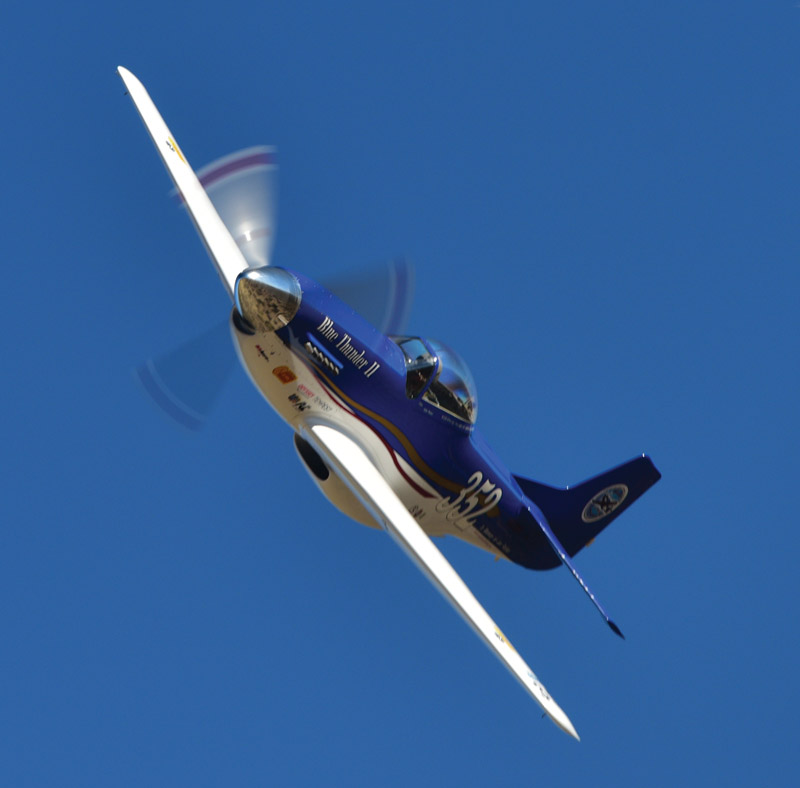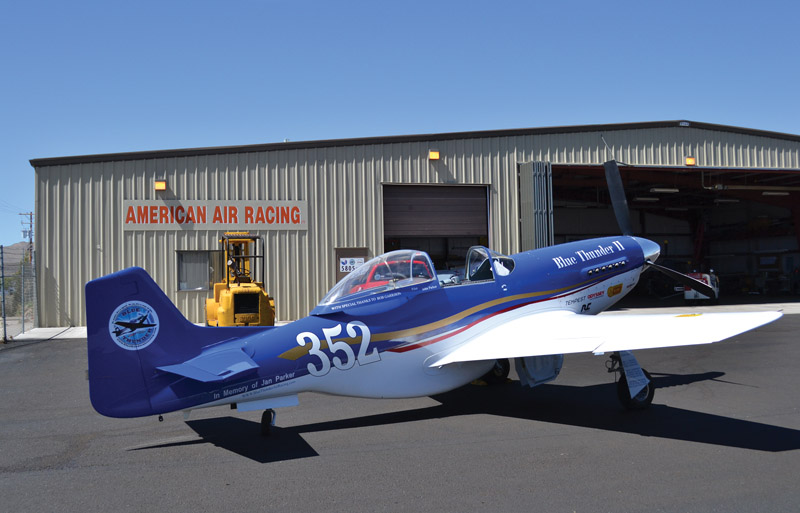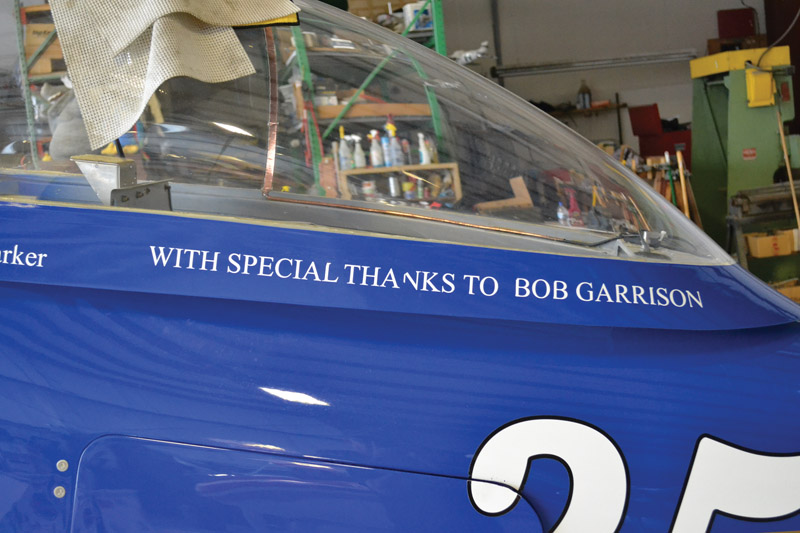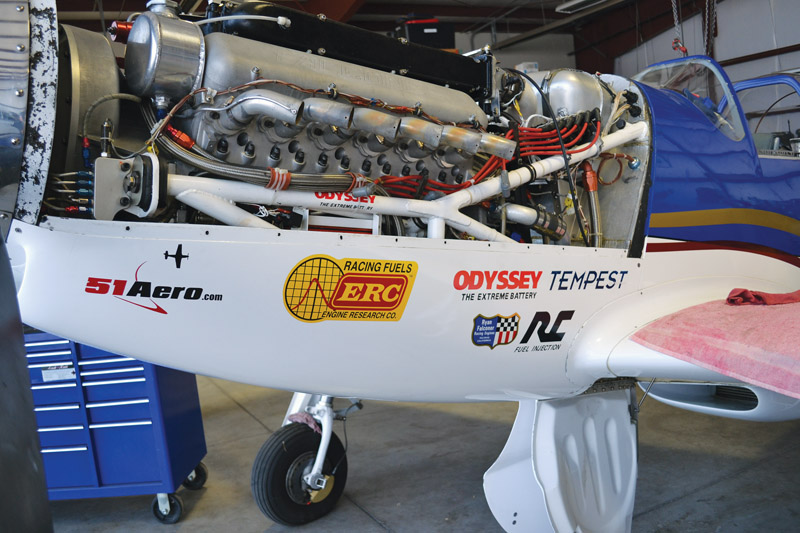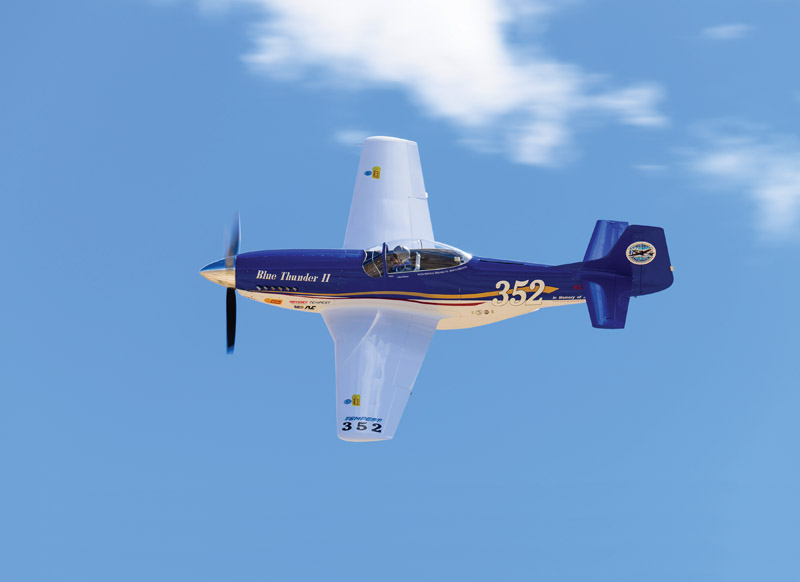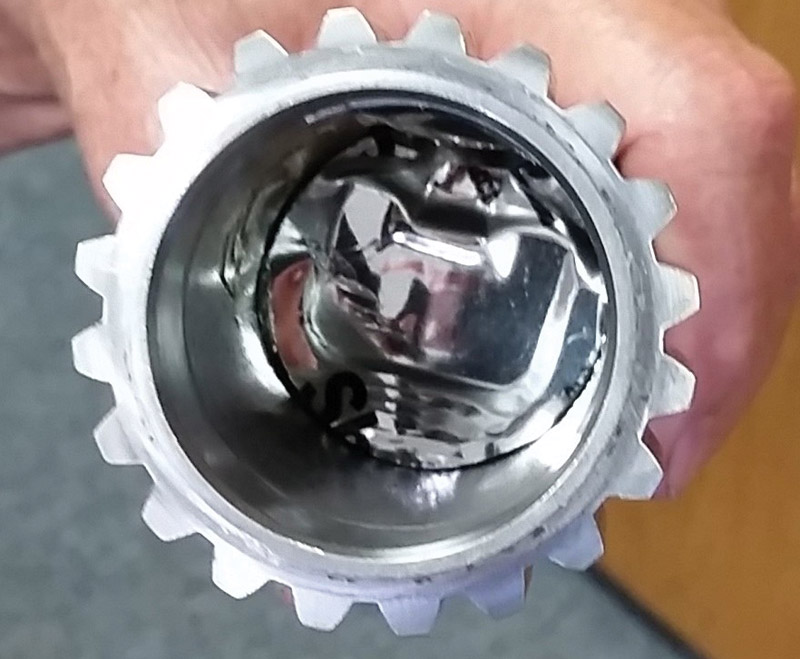The unmistakable shape and sound of a P-51 Mustang screaming close over the ground is an unforgettable experience for many. My introduction to that thrill was as a youngster growing up a few blocks from our town’s airport. It must have been 1949 or 1950 when there was an airshow at the airport, and we neighbor kids sat mesmerized by the aerobatics. And then they came. The Mustangs, four in formation, hot, fast, sleek aluminum bullets making passes near us and over the airport. What a sight. What a sound. There was a grain field east of the runway, and during one pass some pigeons flew up in front of them. Puff—a cloud of feathers. The Mustangs didn’t falter a bit.
Years later that field became a drive-in movie where I worked cleaning up trash to fund my six-dollar-an-hour flight instruction. The airport has since given way to industry, and the grassy field is a Costco now. But that vision of four Mustangs screaming across the field and the throaty roar of those Allison V-12 engines is a permanent overlay in my mind.
Today there are fewer than 300 P-51 Mustangs in various condition (airworthy, collections, or in storage) accounted for in the world. And the numbers are diminishing. It is a beautiful airplane. The lure of the Mustang has spun off into the homebuilt market with scaled-down replicas. The one that tops the market is the Thunder Mustang, a kit plane originally from Idaho, which outperforms the original wartime P-51D. It has a Falconer V-12 engine, and when it screams by, it is close—darn close—to that same sound and sight thrill.
For some, air racing at the Reno Air Races is the ultimate goal, with the Unlimited class taking the main spotlight for its collection of WW-II fighters. With the diminishing number of available piston-powered fighters, homebuilt aircraft have attempted to compete with limited success.
John Parker of Reno, Nevada, has had his golden hands in building winning race planes since the 1960s. His passion for speed locked him into his goal when he formed American Air Racing in 1967. “That is just part of my instinct, part of my DNA,” Parker said. Parker won the Formula One championship three times with his homebuilt American Air Racing Special, which is on display in the EAA Museum in Oshkosh, Wisconsin.
Parker upped the pace when he entered his Glasair in the 1988 Unlimited class. And when the composite Thunder Mustang kit was developed, he believed the Thunder Mustang with the Falconer V-12 engine, along with Thunder Mustang’s advanced technology, was the best kit available for a winning combination. The Thunder Mustang is the most powerful and fastest piston-powered kit aircraft available.
Parker’s first Thunder Mustang, Blue Thunder, Race 351, was raced without a lot of modifications the first year. “I think the first time out we qualified at about 320,” Parker said, “then to 330, then up to 360 or thereabout with that airplane.” Experiments came later. “We experimented with superchargers,” Parker continued, “and those helped at the time, and we were up to 370, 380. We were having all sorts of trouble with belts; the whole operation was just unreliable. So that was that.”
American Air Racing intended to enter Blue Thunder in the Unlimited class with her qualifying speeds near 360 miles per hour. However, the rules were changed, setting the Unlimited class aircraft weight to a minimum of 4000 pounds. This put Blue Thunder into the new Sport class in 1998.
“The first Thunder Mustang was built primarily to the construction manual as a baseline airplane,” Parker said. “At the time we were planning on doing Thunder Mustangs to be what the customer wanted: the finished product. But there was so much time in building the kit, it couldn’t be built for the price. We built four total, two for ourselves and two for customers.”
Parker’s Blue Thunder took second in the 2002 Sport class Gold. Fraught with delays, not always of their own doing, disaster struck before the 2007 air races. During a test, the brakes failed when Parker had a high-speed abort, sending Race 351 off into the sagebrush and causing a fire. The brush fire then caught Race 351 on fire, resulting in a destroyed aircraft.
“We were out of an airplane,” Parker said. “What were we going to do next? We were going to build another airplane. And compliments to Bob Garrison, who not only sold us a kit, but sponsored big-time the construction of it.”
Blue Thunder II, Race 352
Parker’s second Thunder Mustang, Blue Thunder II, Race 352, incorporated several changes over his first. “We did a lot of things differently in the construction process,” he said. “In the control system you’ll notice we don’t have any external trim tabs. A lot of changes to the airplane were to up its flutter speed.1
“We also did a lot of internal things differently: the way the stabilizer is attached; the control systems on the elevators, ailerons, and rudder; the trim system; and the internal plumbing of the airplane. We also changed the angle of incidence2 on the stabilizer and the wing. There were only a few minor external changes.
“We used a different fuel tank sealant in some places, and we used a different adhesive. The adhesive used in number one was extremely toxic. So in places where we could, we used the 3M adhesive.”
Parker did not want to change the outer appearance of the airplane. “The deal is,” he continued, “we still wanted it to look like a Thunder Mustang; we didn’t want it to look like some bastardized kit. We wanted to build it so it could be an icon for the corporation if they wanted to use it as a logo and be proud to put their name on it.
“That was the design objective: make it lighter, make is simpler, make it faster, not specifically to be a racing airplane. It’s faster than the average bear, and we could compete against other Thunder Mustangs and be a winner. And still be close to the poster boy (image) for corporate advertising. We had to. The deal is, we are sponsor driven. And without the sponsors we go away.”
“The differences I talked about you can’t see,” Parker said. “What you can see is the cooler doors and the inlet to the radiators. The inlet is slightly smaller and not as deep.”
The basic Thunder Mustang comes with a 601-cubic-inch, 640-hp Falconer V-12 at 4800 rpm. “When you build the engine, you do the math when you go for horsepower,” he explained. “You do the math toward the camshaft, breathing, and induction, and come up with a spec of what is just perfect and how much horsepower you can get. And when you’ve done the math on the camshaft, the whole valve train, rockers and rocker ratios…you start building toward that. There is just not a whole lot you can do with the induction system because what we have is essentially the only thing that is available. And without going into manufacturing, it is pretty significant.”
Besides making enhancements to the airframe and engine, another way to increase speed is to improve the profile around the racecourse. (Photo: Tom Calderwood)
Exotic Engine Development, Reno, Nevada, prepares the engine for Blue Thunder II. “We are getting a very reliable 900 hp at 6000 rpm,” Parker said. “We had good performance last year and essentially have the same engine now. We haven’t done anything to it other than some polishing and cleanup of the valves and stuff like that over last year’s engine. We made some changes on the valve springs, changes in the valve spring pressure. But did it give us more horsepower? Probably not.”
Parker has two engines for Blue Thunder II—one for racing and one for transport. When asked about the differences, he replied, “Just about everything except the crankshaft. The displacement and the induction system are essentially the same, but the race engine is targeted toward horsepower.”
While we are talking, Parker and his assistant, Mike Cummings (Mike’s Automotive) of Reno, are installing a new propeller governor. “We want to go up to a little more than 6000 rpm,” Parker said. “The governor we had just kind of goes berserk when it’s turning that fast. So you can’t…
“We had an MT Governor; now we have an American Propeller governor. The deal is that the governor drive, regardless of the kind of governor you have, turns very fast, faster than the standard Lycoming or Continental speed. Most governors are not made to turn that fast, so we had to design a prop governor that will control the rpm, turning a lot faster than the average prop governor turns.
“MT and all the manufacturers of all prop governors get their parts from one manufacturer. They make everything: bodies, fly weights, gear drives, all the internal parts. Hartzell, American, and all the others get their parts from the same place. And then they assemble them and put their own name on them.” To solve the governor problem Parker went to the company that made the internal governor parts and had them make modifications for what he needed.
Blue Thunder II looks like a standard Thunder Mustang, but it is significantly faster. (Photo: Tom Calderwood)
Going Faster
When asked what his goal was Parker said, “We are the fastest normally aspired airplane in the world. Nobody really cares, but it is. That is a significant factor. Everything else is turbocharged or supercharged. We are going to attempt to set down a couple laps at 400 and go in the record books at 400 miles per hour. That’s about as far as we are going to be able to go with what we have.
“We did 397, and the objective this year is to set 400 and a fraction…four zero zero point something. We are going much faster than we ever did. It is about the limit. It is about as far as we can achieve with an internal combustion engine and with the limitations that we have with that normally aspired 600-cubic-inch engine.”
Another factor to consider for increasing speed besides the airframe itself and the engine is the profile around the racecourse. “That is probably what we are going to be working on,” Parker said. “As I mentioned before, yes, our data shows that we did go faster than 400 over the ground.”
Blue Thunder II has 97 sensors providing input from the engine and the airframe, including G-forces and position. “It’s a special GPS that records in 5 hertz,” said Parker, “so with that data the computer knows where the airplane is within a few centimeters all the time, and well within a meter. It’s kind of like the next big step. When you look at it, some of the other airplanes are getting close to 420, 425—so what do we need to win?”
Parker continued, “There’s the NXT, a very fast airplane. The bad news is that everything that makes it fast is manual. So, there is a very good chance they’re going to screw up, and that’s the same thing with number 44. It’s a fast airplane, but the pilot is overworked managing the airplane in the right direction. In Blue Thunder II everything is automatic. The telemetry goes to the crew, and if something goes wrong, they can say, ‘hey you have to do something or other.'”
Parker’s crew sits on a balcony that overlooks the entire airport. “They can keep track of the competition, where they are, what the closure rate is, and if I can do anything. Depends on what it is. The telemetry is also for analysis after the fact,” said Parker. “We use it for verifying where we were, how fast we were going, wind direction, and pitch rate. Our telemetry tells the difference between credited distance and actual distance flown, and we can correct something.”
Looking Forward
Parker talked about reaching the future goal of 450 mph: “We can see in the flow simulations that the induction system is just not the optimum for horsepower under what we have. But like I said, we can’t change that without going into some major manufacturing of an induction system.
“There is a ratio that you always have to consider—the bang for the buck. So, how much bang are you going to get for a whole lot of buck?” The Falconer engine and the induction system are built by Ryan Falconer Industries. “Would they build something else? Yes,” Parker continued. “But they are not going to build it for free. Now, would I build one? Yes I would; I would build it for me.
“That would conceivably get us a little more in this environment. We would need roughly 1500 horsepower in order to go roughly 450 mph. How are we going to get that? We are going to get it by turbocharging. Turbocharging—if you do it just right—is free horsepower. If you can tune the turbocharger right in the middle of the airflow map, you can get boost without any horsepower cost. With supercharging, you always have a horsepower cost to drive the mechanical.
“A turbocharger is going to cost something. But you tune it to a single spot, at the maximum horsepower that you want, to the conditions that you need to be operating at. For example in our case at 6000 rpm and 600 cubic inches, we could get 1500 horsepower at three bars. Three bars are tough to get; that’s a lot of boost. It’s theoretical what we can get.
“Would it give us 450 mph?” Parker added. “That’s a different ball game altogether. We not only have an equipment thing, we have a packaging thing. Now if a sponsor comes along and says, ‘Here is the money, I want you to do this…and I want you to do that…and here is all the money you need. What’s it going to cost?’ Well, I don’t know, but it is going to be a lot.”
Wrapping Up
Parker won the 2015 Sports Class Gold with a speed of 377.403 miles per hour. His qualifying speed was 397.251 miles per hour. He won the last two years of the Oshkosh AirVenture Cup. His 2015 winning speed was 323.09 mph. The closest competitor was another Thunder Mustang turning 309.50 mph. Parker upped the scale with a 2016 win of 357.57 mph over the same Thunder Mustang at 263.47 mph.
The original developer of the Thunder Mustang is no longer in business. The assets required to manufacture the airplane were sold to Dean Holt of Mount Vernon, Washington. Holt is currently in the process of manufacturing all the necessary components for a complete kit.
1Flutter is a self-excited divergent oscillation which has led to the loss of various aircraft. It occurs only above a critical airspeed (flutter speed) when sufficient energy is absorbed by the aircraft from the airstream to overcome the structural damping present in one or more modes of vibration and a structural instability results.
2Angle of incidence (sometimes referred to as the mounting angle) is the angle between the chord line of the wing where the wing is mounted to the fuselage and a reference axis along the fuselage (often the direction of minimum drag or, where applicable, the longitudinal axis).

